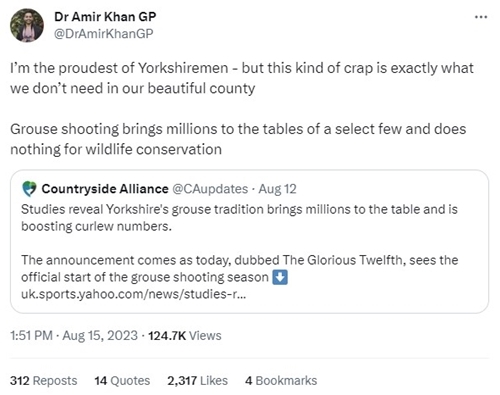By James Swyer, Director of Marketing and Membership
You might have seen some headlines this week, such as this one, around the dismissal of our science. For those who missed it, here’s a quick summary:
Dr Amir Khan, President of the RSPB, took to social media and quoted an article citing recent GWCT research showing that breeding curlews are raising four times as many chicks on the UK’s grouse moors, compared to similar unmanaged moorland sites. Unfortunately, he took this opportunity to claim to his 246,000 followers that grouse shooting “does nothing for wildlife conservation”.

I’ll leave the politics out of it, but we’re contacting Dr Khan and making an offer to show him just what a well-managed grouse moor offers for our red-listed waders.
What matters is the principle. The paper in question, Lethal predator control on UK moorland is associated with high breeding success of curlew, a globally near-threatened wader, was written by GWCT scientists and formally published in an external journal, the European Journal of Wildlife Research. This journal has also been used by RSPB authors.
For it to be published, it must undergo a process called peer review. That means it has been appraised and approved by an editor and reviewed by a panel of appropriate independent experts, who read and assess the paper thoroughly. They consider whether the work is well-performed and valid. Only if the study methodology, analysis and conclusions are up to standard for that journal, is the work published. Any published paper has been through this process and accepted by the journal.
This process underpins the very nature of the GWCT. It provides the scientific community with the reassurance that a piece of work is robust, reliable and impartial. It gives policymakers confidence that the information they’re following is accurate and, in turn, those applying the research on the ground can do so knowing that they’re well-informed.
This also matters in the public space outside of the research world, where misinformation can be rife. We know that it’s untrue that “grouse shooting does nothing for wildlife conservation” because we, and others, have done the research and gone through the process of peer review and publication.
It’s why, in 2020, we launched What The Science Says, a resource to fact-check potentially misleading statements. In that time, we’ve debunked claims ranging from there only being 100 grey partridges left in the UK, that moor owners are draining the moors for grouse and that there are only 100 harvests left on British farms, to name a few.
Scientific integrity matters and runs through who we are as an organisation. It’s often a long and laborious process, but it’s essential. None of the work of our 70+ scientific staff and students would be possible without the support of our members and donors, so thank you. If you’re not yet one of them, please consider giving a few pounds a month to keep the research coming.